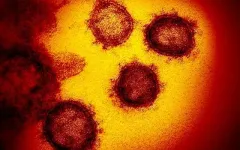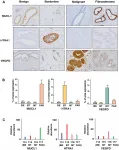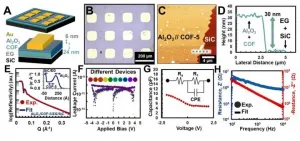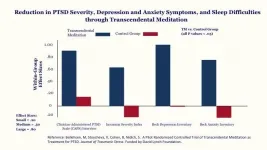(Press-News.org) Using molecular dating tools and epidemiological simulations, researchers at University of California San Diego School of Medicine, with colleagues at the University of Arizona and Illumina, Inc., estimate that the SARS-CoV-2 virus was likely circulating undetected for at most two months before the first human cases of COVID-19 were described in Wuhan, China in late-December 2019.
Writing in the March 18, 2021 online issue of Science, they also note that their simulations suggest that the mutating virus dies out naturally more than three-quarters of the time without causing an epidemic.
"Our study was designed to answer the question of how long could SARS-CoV-2 have circulated in China before it was discovered," said senior author Joel O. Wertheim, PhD, associate professor in the Division of Infectious Diseases and Global Public Health at UC San Diego School of Medicine.
"To answer this question, we combined three important pieces of information: a detailed understanding of how SARS-CoV-2 spread in Wuhan before the lockdown, the genetic diversity of the virus in China and reports of the earliest cases of COVID-19 in China. By combining these disparate lines of evidence, we were able to put an upper limit of mid-October 2019 for when SARS-CoV-2 started circulating in Hubei province."
Cases of COVID-19 were first reported in late-December 2019 in Wuhan, located in the Hubei province of central China. The virus quickly spread beyond Hubei. Chinese authorities cordoned off the region and implemented mitigation measures nationwide. By April 2020, local transmission of the virus was under control but, by then, COVID-19 was pandemic with more than 100 countries reporting cases.
SARS-CoV-2 is a zoonotic coronavirus, believed to have jumped from an unknown animal host to humans. Numerous efforts have been made to identify when the virus first began spreading among humans, based on investigations of early-diagnosed cases of COVID-19. The first cluster of cases -- and the earliest sequenced SARS-CoV-2 genomes -- were associated with the Huanan Seafood Wholesale Market, but study authors say the market cluster is unlikely to have marked the beginning of the pandemic because the earliest documented COVID-19 cases had no connection to the market.
Regional newspaper reports suggest COVID-19 diagnoses in Hubei date back to at least November 17, 2019, suggesting the virus was already actively circulating when Chinese authorities enacted public health measures.
In the new study, researchers used molecular clock evolutionary analyses to try to home in on when the first, or index, case of SARS-CoV-2 occurred. "Molecular clock" is a term for a technique that uses the mutation rate of genes to deduce when two or more life forms diverged -- in this case, when the common ancestor of all variants of SARS-CoV-2 existed, estimated in this study to as early as mid-November 2019.
Molecular dating of the most recent common ancestor is often taken to be synonymous with the index case of an emerging disease. However, said co-author Michael Worobey, PhD, professor of ecology and evolutionary biology at University of Arizona: "The index case can conceivably predate the common ancestor -- the actual first case of this outbreak may have occurred days, weeks or even many months before the estimated common ancestor. Determining the length of that 'phylogenetic fuse' was at the heart of our investigation."
Based on this work, the researchers estimate that the median number of persons infected with SARS-CoV-2 in China was less than one until November 4, 2019. Thirteen days later, it was four individuals, and just nine on December 1, 2019. The first hospitalizations in Wuhan with a condition later identified as COVID-19 occurred in mid-December.
Study authors used a variety of analytical tools to model how the SARS-CoV-2 virus may have behaved during the initial outbreak and early days of the pandemic when it was largely an unknown entity and the scope of the public health threat not yet fully realized.
These tools included epidemic simulations based on the virus's known biology, such as its transmissibility and other factors. In just 29.7 percent of these simulations was the virus able to create self-sustaining epidemics. In the other 70.3 percent, the virus infected relatively few persons before dying out. The average failed epidemic ended just eight days after the index case.
"Typically, scientists use the viral genetic diversity to get the timing of when a virus started to spread," said Wertheim. "Our study added a crucial layer on top of this approach by modeling how long the virus could have circulated before giving rise to the observed genetic diversity.
"Our approach yielded some surprising results. We saw that over two-thirds of the epidemics we attempted to simulate went extinct. That means that if we could go back in time and repeat 2019 one hundred times, two out of three times, COVID-19 would have fizzled out on its own without igniting a pandemic. This finding supports the notion that humans are constantly being bombarded with zoonotic pathogens."
Wertheim noted that even as SARS-CoV-2 was circulating in China in the fall of 2019, the researchers' model suggests it was doing so at low levels until at least December of that year.
"Given that, it's hard to reconcile these low levels of virus in China with claims of infections in Europe and the U.S. at the same time," Wertheim said. "I am quite skeptical of claims of COVID-19 outside China at that time."
The original strain of SARS-CoV-2 became epidemic, the authors write, because it was widely dispersed, which favors persistence, and because it thrived in urban areas where transmission was easier. In simulated epidemics involving less dense rural communities, epidemics went extinct 94.5 to 99.6 percent of the time.
The virus has since mutated multiple times, with a number of variants becoming more transmissible.
"Pandemic surveillance wasn't prepared for a virus like SARS-CoV-2," Wertheim said. "We were looking for the next SARS or MERS, something that killed people at a high rate, but in hindsight, we see how a highly transmissible virus with a modest mortality rate can also lay the world low."
INFORMATION:
Co-authors include: Jonathan Pekar and Niema Moshiri, UC San Diego; and Konrad Scheffler, Illumina, Inc.
PROVIDENCE, R.I. [Brown University] -- In 2018, physicists showed that something interesting happens when two sheets of the nanomaterial graphene are placed on top of each other. When one layer is rotated to a "magic angle" of around 1.1 degrees with respect to the other, the system becomes a superconductor -- meaning it conducts electricity with zero resistance. Even more exciting, there was evidence that it was an unconventional form of superconductivity -- a type that can happen at temperatures well above absolute zero, where most superconducting materials function.
Since the initial discovery, researchers have been working to understand this exotic state of matter. Now, a research ...
Researchers at Baylor College of Medicine and the Jan and Dan Duncan Neurological Research Institute at Texas Children's Hospital (NRI) have identified and characterized two regions of DNA required for the proper expression of Mecp2/MECP2 in mice and humans.
These findings, published in Genes & Development, are helping to shed light on the function of these DNA regions and how they could be potential targets for diagnostic and therapeutic interventions for intellectual disabilities such as Rett Syndrome and MECP2 Duplication Syndrome.
Both of these intellectual disabilities are examples of the importance of precise MeCP2 protein levels for proper brain function. A decrease in this protein leads to Rett Syndrome, while an increase in this protein ...
A set of surveys fielded last year found that a large majority of U.S. adults support COVID-19 mitigation measures, including indoor mask wearing, social distancing, and contact tracing, with significant differences across certain groups. The surveys, which followed the same people in April, July, and November 2020, were conducted by a team of researchers at the Johns Hopkins Bloomberg School of Public Health with colleagues at the SNF Agora Institute at Johns Hopkins University.
Overall public support for COVID-19 mitigation measures was strongest in April 2020 with support remaining high in July and November. The November survey found that 79 percent of U.S. adults supported mask wearing, 78 percent supported social distancing, ...
While the drug tamoxifen reduces the risk of developing breast cancer and prevents recurrence, the side-effects cause many women to discontinue their treatment. A study involving researchers at Karolinska Institutet in Stockholm has now found that a much lower dose than the standard produces a good effect with fewer adverse reactions in women who have yet to enter the menopause. The study, which has been published in the Journal of Clinical Oncology, can play a significant role in the treatment of cancer.
The anti-hormone drug tamoxifen has been used for over 40 years to reduce the risk of relapse in women who have been treated for hormone-related ...
Oncotarget published "Quantitative proteome profiling stratifies fibroepithelial lesions of the breast" which reported that the current grading system remains unreliable in differentiating these tumors due to histological heterogeneity and lack of appropriate markers to monitor the sudden and unpredictable malignant transformation of PTs.
The high- throughput quantitative proteomic analysis suggested that FAD and PTs form distinct clusters away from borderline and malignant though there exist marked differences between them.
Interestingly, over-expression of extracellular matrices related proteins and epithelial-mesenchymal transition markers in borderline PTs led these authors to hypothesize a model of deposition and degradation leading to ECM remodeling and EMT acquisition ...
DALLAS, March 17, 2021 -- Immediate angiography, rather than the standard computed tomography (CT scan), reduced stroke treatment time and was linked to improved recovery, according to late-breaking science presented today at the American Stroke Association's International Stroke Conference 2021. The virtual meeting is March 17-19, 2021 and is a world premier meeting for researchers and clinicians dedicated to the science of stroke and brain health.
Standard emergency department treatment for stroke patients involves a CT scan, which uses X-rays to pinpoint the presence and location of a blood clot. Angiography is an advanced X-ray imaging method that uses a catheter, or thin tube, inserted into the blood vessel to find the location and size ...
DALLAS, March 17, 2021 -- Stroke patients treated via a mobile stroke unit (MSU) received clot-busting medications faster and more often - and recovered significantly better than patients who receive regular emergency care by standard ambulance, according to late-breaking science presented today at the American Stroke Association's International Stroke Conference 2021. The virtual meeting is March 17-19, 2021 and is a world premier meeting for researchers and clinicians dedicated to the science of stroke and brain health.
"Our goal in this study was to treat patients on the mobile stroke unit within an hour of the onset of their stroke ...
CHARLOTTESVILLE, Va. - Progress in the field of integrated circuits is measured by matching, exceeding, or falling behind the rate set forth by Gordon Moore, former CEO and co-founder of Intel, who said the number of electronic components, or transistors, per integrated circuit would double every year. That was more than 50 years ago, and surprisingly his prediction, now called Moore's Law, came true.
In recent years, it was thought that the pace had slowed; one of the biggest challenges of putting more circuits and power on a smaller chip is managing heat.
A multidisciplinary group that includes Patrick E. Hopkins, a professor in the University of Virginia's Department of Mechanical and Aerospace ...
In 1958, a magnitude 7.8 earthquake triggered a rockslide into Southeast Alaska's Lituya Bay, creating a tsunami that ran 1,700 feet up a mountainside before racing out to sea.
Researchers now think the region's widespread loss of glacier ice helped set the stage for the quake.
In a recently published research article, scientists with the University of Alaska Fairbanks Geophysical Institute found that ice loss near Glacier Bay National Park has influenced the timing and location of earthquakes with a magnitude of 5.0 or greater in the area during the past century.
Scientists have ...
Veterans with PTSD who practiced the Transcendental Meditation technique showed significant reductions in PTSD symptom severity, according to a new study published today in Journal of Traumatic Stress. Fifty percent of the meditating veterans no longer met criteria for PTSD after three months compared to only 10 percent of controls. The randomized controlled study also showed significant reductions in veterans' symptoms of depression and anxiety, and sleep difficulties.
"Transcendental Meditation is a non-trauma-focused, easy-to-learn technique that was found in this study to improve PTSD symptoms, likely through the experience of physical rest," said Mayer Bellehsen, Ph.D., director of the Unified Behavioral Health Center for Military Veterans and their Families, ...






